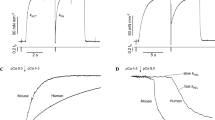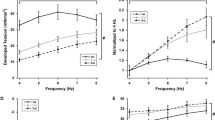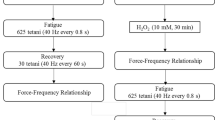Abstract
(1) Small cardiac myofibrillar preparations were obtained from the right ventricle of normal (129/ReJ) and dystrophic (129/ReJ dy/dy) mice and were chemically skinned in a relaxing solution by exposure to Triton X-100 (3% v/v). (2) The isometric force produced in these skinned cardiac preparations at different sarcomere lengths was measured in solutions of different [Ca2+] and ionic strength. The effect of the negative inotropic drug 2,3-butanedione monoxime (BDM), which is known to act at the myofibrillar level was also investigated. (3) The murine cardiac preparation from normal animals was found to develop 50% maximal force at a pCa (=−log10[Ca2+]) of 5.59±0.08 and 5.94±0.03 (mean ±SD) under physiological (ionic equivalents concentration, I=154 mM; pH 7.10; [Mg2+] 1 mM) and low ionic strength (I=94 mM; pH 7.10; [Mg2+] 1 mM) conditions respectively. The isometric force curves were significantly shallower at low ionic strength (Hill coefficient, 1.8±0.1) than at physiological ionic strength (Hill coefficient, 2.6±0.3) and the sarcomere length effect on the force-pCa relation was markedly reduced at lower ionic strength. (4) Increasing BDM concentrations in solutions up to 100 mM reduced the maximum Ca2+-activated force of cardiac preparations from normal mice to less than 6% of the control values in a dose dependent fashion. BDM also rendered the cardiac preparations less sensitive to Ca2+ by a factor of up to 1.5 in a process which showed saturation at BDM concentrations higher than 15 mM. (5) Cardiac preparations from dystrophic animals compared with those from normal mice were significantly more sensitive to Ca2+ under physiological conditions, were more sensitive to the action of BDM at concentrations higher than 15 mM, changed sensitivity to Ca2+ less following a change in sarcomere length and in general were less affected by a decrease in ionic concentration. (6) The results indicate that dystrophy in mice affects the characteristics of both the contractile and regulatory systems of cardiac muscle and that BDM directly affects the Ca2+-activated contractile response possibly by binding to saturable sites on the myofilaments.
Similar content being viewed by others
References
Allen DG, Kentish JC (1985) The cellular basis of the length tension relation in cardiac muscle. J Mol Cell Cardiol 17:821–840
Ashley CC, Moisescu DG (1977) Effect of changing the composition of the bathing solutions upon the isometric tension-pCa relationship in bundles of crustacean myofibrils. J Physiol 270:627–652
Blanchard EM, Mulieri LA, Alpert NR (1984) The effect of 2,3-butanedione monoxime (BDM) and the relation between initial heat and mechanical output of rabbit papillary muscle. Biophys J 45:48a
Blanchard EM, Alpert NR, Allen DG, Smith GL (1988) The effect of 2,3-butanedione monoxime on the initial heat-tension-time integral relation and aequorin light output from ferret papillary muscles. Biophys J 53:605a
Brandt PW, Cox RN, Kawai M, Robinson T (1982) Regulation of tension in skinned muscle fibres. Effect of crossbridge kinetics on apparent Ca2+ sensitivity. J Gen Physiol 79:997–1016
Fabiato A (1981) Myoplasmic free calcium concentration reached during the twitch of an intact isolated cardiac cell and during calcium-induced release of calcium from the sarcoplasmic reticulum of a skinned cardiac cell from the adult rat or rabbit. J Gen Physiol 78:457–497
Fabiato A, Fabiato F (1978) Myofilament-generated tension oscillations during partial calcium activation and activation dependence of sarcomere length-tension relation of skinned cardiac cells. J Gen Physiol 72:667–699
Fink RHA, Stephenson DG, Williams DA (1986a) Potassium and ionic strength effects on the isometric force of skinned twitch muscle fibres of the rat and toad. J Physiol 370:317–337
Fink RHA, Stephenson DG, Williams DA (1986b) Calcium and strontium activation of single skinned muscle fibres of normal and dystrophic mice. J Physiol 373:513–525
Fryer MW, Neering IR, Stephenson DG (1988) Effects of 2,3-butanedione monoxime on the contractile activation properties of fast and slow-twitch rat muscle fibres. J Physiol 408:53–75
Gulati J, Podolsky RJ (1978) Contraction transients of skinned muscle fibres: Effects of calcium and ionic strength. J Gen Physiol 72:701–716
Heymsfield SB, McNish T, Perkins JV, Felner JM (1978) Sequence of cardiac changes in Duchenne muscular dystrophy. Am Heart J 95:283–294
Hibberd MG, Jewell BR (1982) Calcium and length-dependent force production in rat ventricular muscle. J Physiol 329:527–540
Hunter SH (1980) The heart in muscular dystrophy. Br Med Bull 36:133–134
Kentish JC (1984) The inhibitory effects of monovalent ions on force development in detergent-skinned ventricular muscle from guinea pig. J Physiol 352:353–374
Kentish JC, Ter Keurs HEDJ, Noble MIM, Ricciardi L, Schouten VJA (1983) The relationships between force, [Ca2+] and sarcomere length in skinned trabeculae from rat ventricle. J Physiol 345:24P
Li T, Sperelakis N, Teneick RE, Solaro RJ (1985) Effects of diacetyl monoxime on cardiac excitation-contraction coupling. J Pharmacol Exp Ther 232:688–695
Lucas-Heron B, Loirat MJ, Ollivier B, and Leoty C (1987) Calciumrelated defects in cardiac and skeletal muscles of dystrophic mice. Comp Biochem Physiol 86B:295–301
Matsubara I, Elliott GF (1972) X-ray diffraction studies on skinned single fibres of frog skeletal muscle. J Mol Biol 72:657–669
Moisescu DG (1976) Kinetics of reaction in calcium-activated skinned muscle fibres. Nature 262:610–613
Moisescu DG, Pusch H (1975) A pH-metric method for the determination of the relative concentration of calcium to EGTA. Pflügers Arch 355:R122
Moisescu DG, Thieleczek R (1978) Calcium and strontium concentration changes within skinned muscle preparations following a change in the external bathing solution. J Physiol 275:241–262
Moisescu DG, Thieleczek R (1979) Sarcomere length effects on the Sr2+ and Ca2+ activation curves in skinned frog muscle fibres. Biochem Biophys Acta 546:64–76
Rees BB, Stephenson DG (1987) Thermal dependence of maximum Ca2+-activated force in skinned muscle fibres of the toadBufo marinus acclimated at different temperatures. J Exp Biol 129:309–327
Robertson SP, Johnson JD, Holroyde MJ, Kranias EG, Potter JD, Solaro RJ (1982) The effect of troponin I phosphorylation on the Ca2+ binding properties of the Ca2+-regulatory site of bovine cardiac troponin. J Biol Chem 257:260–263
Rosenfeld SS, Taylor EW (1985) Kinetic studies of calcium binding to regulatory complex from skeletal muscle. J Biol Chem 260:252–261
Stienen GJM, Blange T, Treijtel BW (1985) Tension development and calcium sensitivity in skinned muscle fibres of the frog. Pflügers Arch 405:19–23
Stephenson DG, Wendt IR (1984) Length dependence of changes in sarcoplasmic calcium concentration and myofibrillar calcium sensitivity in striated muscle fibres. J Muscle Res Cell Motil 5:243–272
Stephenson DG, Wendt IR (1986) Effects of procaine on calcium accumulation by the sarcoplasmic reticulum of mechanically disrupted rat cardiac muscle. J Physiol 373:195–207
Stephenson DG, Williams DA (1981) Calcium-activated force responses in fast- and slow-twitch skinned muscle fibres of the rat at different temperatures. J Physiol 317:281–302
Stephenson DG, Wendt IR, Forrest OG (1981) Non-uniform ion distributions and electrical potentials in sarcoplasmic regions of skeletal muscle fibres. Nature 289:690–692
Walsh TP (1987) Molecular regulation of thick and thin filaments: to control or controlled. Proc Aust Physiol Pharmacol Soc 18:79–88
Wendt IR, Stephenson DG (1983) Effects of caffeine on Ca2+-activated force production in skinned cardiac and skeletal muscle fibres of the rat. Pflügers Arch 398:210–216
West JM, Stephenson DG (1986) The effect of 2,3-butanedione monoxime (BDM) on cardiac muscle from normal and dystrophic mice. Proc Aust Physiol Pharmacol Soc 17:196P
West JM, Stephenson DG (1987) Ca2+-activation properties of chemically skinned cardiac cells from normal and dystrophic mice (Strain 129/ReJ). Proc Aust Physiol Pharmacol Soc 18:50P
Wiggins JR, Reiser J, Fitzpatrick DF, Bergey JL (1980) Inotropic actions of diacetyl monoxime in cat ventricular muscle. J Pharmacol Exp Ther 212:217–224
Author information
Authors and Affiliations
Rights and permissions
About this article
Cite this article
West, J.M., Stephenson, D.G. Contractile activation and the effects of 2,3-butanedione monoxime (BDM) in skinned cardiac preparations from normal and dystrophic mice (129/ReJ). Pflugers Arch. 413, 546–552 (1989). https://doi.org/10.1007/BF00594187
Received:
Revised:
Accepted:
Issue Date:
DOI: https://doi.org/10.1007/BF00594187




